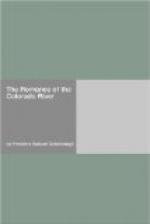* For a full account of the experiences of Alvar Nunez, see the translation of Buckingham Smith. Also Bandolier, Contributions to the History of the Southwestern Portions of the United States.
“And thus sailing [he writes] we always found more shallow water, and the sea thick, black, and very muddy, and came at length into five fathom water; and seeing this we determined to pass over to the land which we had seen on the other side, and here likewise we found as little depth or less, whereupon we rode all night in five fathom water, and we perceived the sea to run with so great a rage into the land that it was a thing much to be marveled at; and with the like fury it returned back again with the ebb, during which time we found eleven fathom water, and the flood and ebb continued from five to six hours.” The next day the captain and the pilot went up to the ship’s top and saw all the land full of sand in a great round compass and joining itself with the other shore; and it was so low that whereas we were a league from the same we could not discern it, and it seemed there was an inlet of the mouths of certain lakes, whereby the sea went in and out. There were divers opinions amongst us, and some thought that that current entered into these lakes, and also that some great river there might be the cause thereof."*
* From Hakluyt’s Voyages. The spelling has been modernised.
This seems to have been the very first visit of Europeans to the mouth of the Colorado, but as Ulloa did not see the river, and only surmised that there might be one there, it cannot be considered in any way a discovery. It has been supposed by some that Friar Juan de la Asumpcion, in 1538, might have reached the Colorado in his deep river which he could not cross, but this river was more likely a branch of the Yaqui, for the friar was told that ten days beyond, to the north, there was another larger river settled by many people, whose houses had three stories, and whose villages were enclosed. This describes the Rio Grande and its southern settlements perfectly, so that, had he been on the Colorado, or even the Gila, the Rio Grande could not have been described as “ten days to the north.” Ulloa took possession formally, according to Spanish custom, and then sailed




